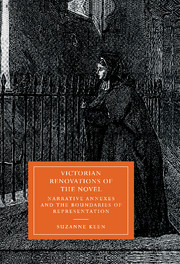Book contents
- Frontmatter
- Contents
- Acknowledgments
- 1 Narrative annexes: altered spaces, altered modes
- 2 Victorian critics, narrative annexes, and prescriptions for the novel
- 3 Norms and narrow spaces: the gendering of limits on representation
- 4 Narrative annexes, social mobility, and class anxiety
- 5 Older, deeper, further: narrative annexes and the extent of the Condition of England
- 6 Victorian annexes and modern form
- Notes
- Bibliography
- Index
- CAMBRIDGE STUDIES IN NINETEENTH-CENTURY LITERATURE AND CULTURE
3 - Norms and narrow spaces: the gendering of limits on representation
Published online by Cambridge University Press: 13 November 2009
- Frontmatter
- Contents
- Acknowledgments
- 1 Narrative annexes: altered spaces, altered modes
- 2 Victorian critics, narrative annexes, and prescriptions for the novel
- 3 Norms and narrow spaces: the gendering of limits on representation
- 4 Narrative annexes, social mobility, and class anxiety
- 5 Older, deeper, further: narrative annexes and the extent of the Condition of England
- 6 Victorian annexes and modern form
- Notes
- Bibliography
- Index
- CAMBRIDGE STUDIES IN NINETEENTH-CENTURY LITERATURE AND CULTURE
Summary
VICTORIAN NORMS: THE PLACES OF NOVEL AND ROMANCE
In the Victorian novel, norms of representation and standards regarding genres are often embodied in spatial metaphors of “realm” and “region,” and both Victorian novelists and critics contribute to the sense of separation keeping “novel” and “romance” and their respective plots and subjects of representation apart. Although the fictional worlds of Victorian novels are more heterogeneous than this dichotomy suggests, the terms “romance” and “novel” refer to opposite kinds of fictional worlds, related to the actual world and its probabilities to a lesser and greater degree. Nathaniel Hawthorne articulates the opposition in his preface to The House of The Seven Gables (1851), writing in an often-cited passage:
When a writer calls his work a Romance, it need hardly be observed that he wishes to claim a certain latitude, both as to its fashion and material, which he would not have felt himself entitled to assume, had he professed to be writing a Novel. The latter form of composition is presumed to aim at a very minute fidelity, not merely to the possible, but to the probable and ordinary course of man's experience. The former – while as a work of art, it must rigidly subject itself to laws, and while it sins unpardonably so far as it may swerve aside from the truth of the human heart – has fairly a right to present that truth under circumstances, to a great extent, of the writer's own choosing or creation … The point of view in which this tale comes under the Romantic definition lies in the attempt to connect a bygone time with the very present that is flitting way from us.
- Type
- Chapter
- Information
- Victorian Renovations of the NovelNarrative Annexes and the Boundaries of Representation, pp. 65 - 110Publisher: Cambridge University PressPrint publication year: 1997



